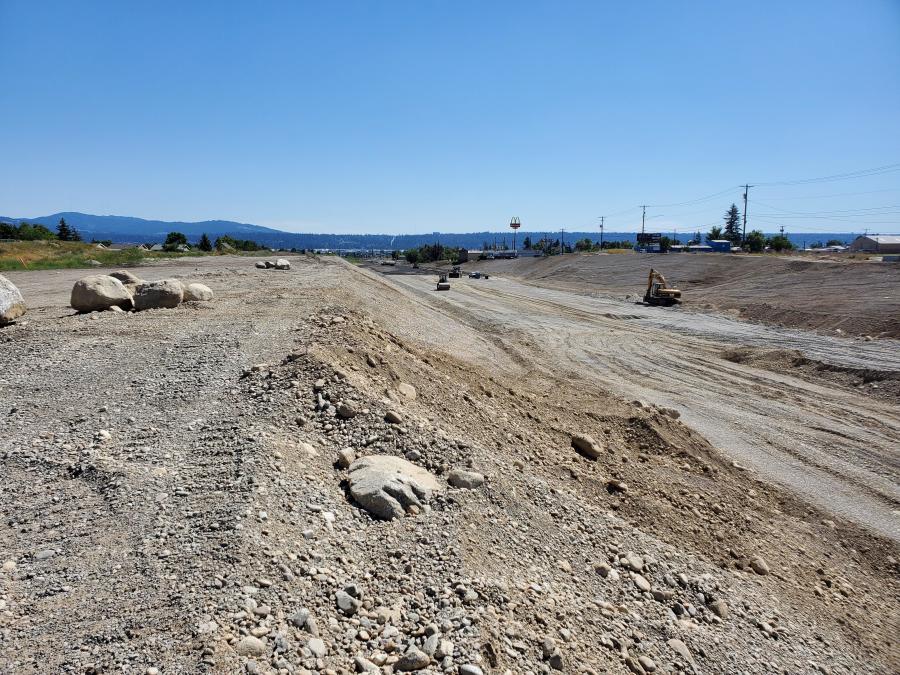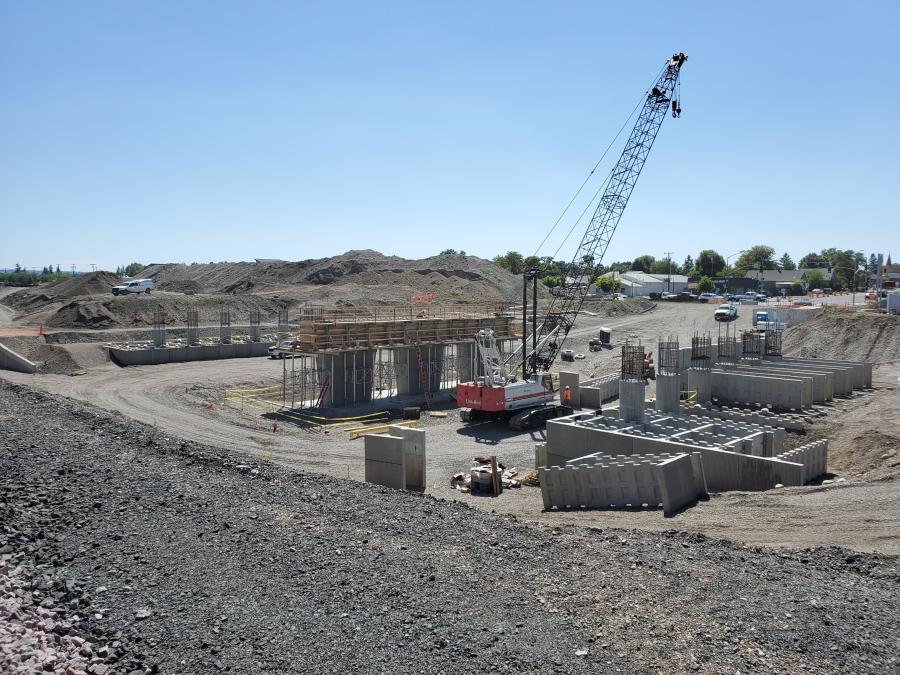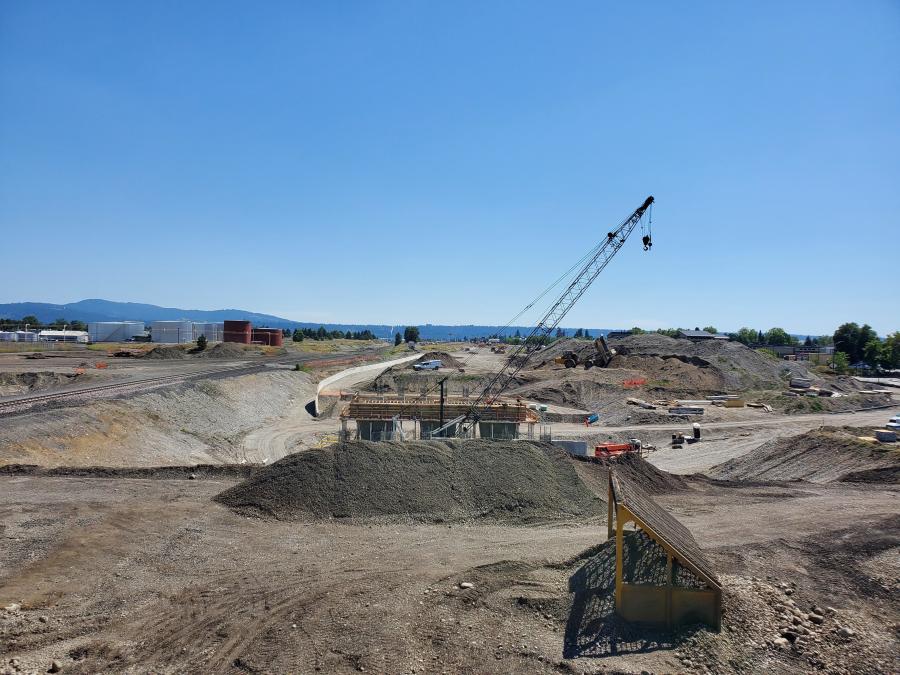Spokane-based Max J. Kuney was the contractor for the Freya Street structures, part of the $2.2 billion North Spokane Corridor Project, which included two main-line freeway bridges over Freya, just north of Francis Avenue. Kuney, a family-owned company since 1930, focused on the transportation, bridgework and piling.
Approximately half of the U.S. Route 395 North Spokane Corridor has been completed and is now operational. The Washington State Department of Transportation is managing the project – a 10.5-mi. north-south section of freeway along the eastern border of Spokane, Wash., designed to improve freight and commuter mobility through the metropolitan area.
When work is finally finished, the North Spokane Corridor will be a limited access highway along a new alignment that connects to I-90 on the south end west of the existing Thor/Freya Interchange and to existing U.S. 2 at Farwell Road and U.S. 395 at Wandermere on the north end. It is expected to carry more than 150,000 vehicles per day.
Work Plan
Spokane-based Max J. Kuney was the contractor for the Freya Street structures project, which included two main-line freeway bridges over Freya, just north of Francis Avenue. Kuney, a family-owned company since 1930, focuses on the transportation, bridge and piling markets and worked on WSDOT's first Design-Build contract in 2000 — the Thurston Way Interchange. In addition to freeway widening projects and bridge building, Kuney takes on high-profile contracts, such as the Foss Waterway bridge in Tacoma, Wash., one of only 13 cable stay bridges in the United States at the time, with towers reaching 214 ft. tall, completed in 1994.
In addition to construction of the two bridges, the project also includes embankment, surfacing, asphalt and concrete paving, fencing, a traffic barrier, curb and sidewalk improvements, and landscaping work. The $7.6 million project was completed in 2018.
Construction will progress from north to south, with projects at multiple locations. The second BNSF Rail Realignment broke ground in 2019. Wellesley Ave Improvements and the Spokane River to Columbia start this year, with work on the Spokane River Crossing commencing in 2021, Sprague Avenue to Spokane River in 2022, and I-90 to Sprague Avenue in 2023.
As work resumes on the Wellesley Avenue interchange, crews continue working on other projects, including:
- NSC from Carlisle Ave. to Wellesley Ave.
- Realignment and relocation of the BNSF railroad track to prepare for future NSC mainline alignment from Rowan Ave. to Cleveland Ave.
- Construction of a bridge over Euclid Ave.
- Construction of the Children of the Sun Trail and pedestrian-only bridges and other amenities that are part of the shared-use trail
- Twin bridges from Carlisle Ave. to south of Sprague Ave.
In addition to general travel lanes, right of way is being reserved for a future high-capacity transit system with park-and-ride lots.
"The NSC project includes a companion multiuse path for the full length of the corridor," Hilmes said.
The bicycle and pedestrian trail has been named the "Children of the Sun Trail."
"We are actively engaging the public on the remaining portion of the NSC and Children of the Sun trail through a process call ‘placemaking'," said Bob L. Hilmes, project engineer of the WSDOT Eastern Region. Hilmes "Placemaking combines community assets with input and inspiration in order to create public spaces that promote well-being."
Construction Schedule
As part of a $2.2 billion project, only the northern 5.42 mi. have been completed. The southern section received state funding in 2015. Work began in 2017 and was expected to be completed by 2029. That timeline, however, has been altered, adding at least one year to the expected completion date, because between $45 million and $50 million in work to construct the freeway between Sprague Avenue and the Spokane River was deferred in late 2019 after passage of Initiative 976, which limit car tabs to $30 a year and resulted in a $4 million shortage.
"We are progressing on the NSC from the north to the south," said Hilmes. "The Columbia-to-Freya project completes the interchange with Freya and was scheduled to be completed this spring. However, construction is currently at a standstill so completion will be delayed."
The corridor extension was designed to open in sections as work progresses from north to south. However, Hilmes said, "We will not be placing traffic on the NSC south of Freya until the interchange at Wellesley Avenue is completed."
Wellesley Avenue between Market Street and Freya Street was closed in November 2019. The interchange is not expected to reopen until late 2022 or early 2023.
Long Time Coming
Since the groundbreaking celebration in August 2001, dozens of construction companies have built more than 5.5 mi. of freeway, three interchanges, 30 bridges, one railroad tunnel and a multi-use trail that parallels the NSC. But progress has been slow.
Ranked 19 of 43 on the Congressional High Priority Corridor list of the National Highway System, the NSC hasn't exactly been fast-tracked. The Federal Highway Administration approved the Final Environmental Impact Statement in 1997, with a supplemental FEIS for the Spokane River north to U.S. 395 at the Wandermere section earning approval in 2000.
The project's first phase was the Hawthorne Road to U.S. 2 job, a grading and drainage job that was completed in 2002.
The first driveable segment of the project opened to traffic in 2009: the first Nickel Project – named due to the 2003 State Nickel Gas Tax Package, which allocated $321 million to fund design, right-of-way purchases and construction between 2003 to 2011 – Francis to Farwell. The nickel tax also funded the U.S. 2 Wandermere and U.S. 2 Lowering projects.
By fall 2012, the north half of the NSC was open to traffic. The same year, work began on the Francis Avenue bridge replacement project. When it was opened to traffic in 2014, the remainder of the NSC projects lacked more than half the necessary funding – a situation that wasn't addressed until the 2015 Connecting Washington legislation passed.
Other portions of the project that have been completed include:
- BNSF Structures and Railway realignment, using TIGER IV Grant Funds, completed 2015
- Construction of a roundabout to improve the Wellesley/Freya intersection, completed 2016
- Construction of two mainline NSC structures over Freya Street, completed 2019
- Columbia Avenue to Freya Street PCC Paving Project, completion 2019
- The first project on the south half – the Francis Avenue Bridge Replacement Project, completed 2014
Funding
Funding for the NSC comes from a number of sources. Pre-existing funds amounted to $158,435,000. The 2003 Nickel Gas Tax added $292,614,000. Another gas tax in 2005 contributed an additional $92,478,000. The Transportation Partnership Act, or State 9.5-cent tax, was implemented to fund the project between 2007 and 2019, providing money for right-of-way acquisitions north and south along I-90, between the Liberty Park Interchange and the Sprague Avenue Interchange, for the future Collector/Distributor System and to design and construct a noise wall project along this same section of I-90. This allocation also provided funding to design the "shovel ready," southbound lanes project between the Francis/Freya and Farwell Interchanges.

The Washington State Legislature allocated an additional $28 million in TPA funds for the corridor in 2009. WSDOT used this funding in the Hillyard area, from the Spokane River to the Francis/Freya Interchange. Total TPA funding for the corridor amounts to $180 million ($152 million in 2005, plus $28 million in 2009).
Other allotments came from Special Cat ($69,272,000) and Connecting Washington ($879,900,000), a package passed by the legislature in 2015 to pay for the completion to I-90. Connecting Washington is a $16 billion revenue package that allocates funding for mega-projects, preservation and maintenance, service, ferries and multi-modal transportation projects. This package includes an 11.9 cent gas tax increase.
Total funding for the NSC amounts to $1,491,699,000.
Benefits
Conceived as long ago as the 1940s, this project will run about one mile east of where it was originally planned in the 1960s and 1970s. The new NSC will help decrease travel time, fuel usage and congestion through metropolitan Spokane. WSDOT predicts a travel time between Wandermere and I-90 will be shortened to 12 minutes once work is completed.
Safety will be improved by re-directing trucks from the local arterials to the freeway. The NSC will bypass the busy Division Street corridor, reducing pollution as well as traffic congestion.
Since 2001, there hasn't been a year that the NSC hasn't been worked on. Locals are hoping that by 2030, work will at long last be finished. CEG
Lori Lovely
Lori Lovely is an award-winning journalist, editor and author of the children's book Isadora's Dance. She has worked for newspapers, magazines and niche publications, covering a wide-ranging list of topics that includes motor sports, construction, MSW, energy, environmental issues, water, animal rights and issues, history, Native American issues and people, real estate and home decor, farming and more. Her degrees in History taught this dedicated professional to research thoroughly and ask detailed questions in order to winnow interesting facts that convey the essence of the story. As a seasoned writer and compassionate storyteller, she accurately portrays the subject in a manner that entrances the reader.
When she's not working on assignment, Lori is tending to her historic Indiana farm, where she raises alpacas. An inveterate animal lover, this vegetarian enjoys spending time with her animals and working in her garden.
Read more from Lori Lovely here.
Today's top stories




















